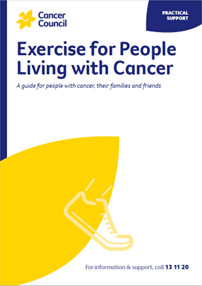- Home
- Cancer Information
- Living well
- Exercise for people living with cancer (with videos)
- Strength and resistance (video)
Strength and resistance training
Strength and resistance training uses weights or other resistance to increase the size, strength and endurance of your muscles, and to strengthen bones. It is sometimes called weight training.
Learn more about:
- Overview
- How much training should I do?
- Core exercises (includes video)
- Upper body exercises (includes video)
- Leg exercises (includes video)
Overview
The weights or resistance that can be used include:
- your own body weight – you use body weight for push-ups, pull-ups from the floor or against a wall, and squats, yoga and matwork Pilates
- free weights – this includes dumbbells and barbells, hand weights and weighted bags which you hold, along with wrist and ankle weights which you attach with straps
- weights or resistance machines – these are devices that have adjustable seats or handles attached to either weights or hydraulics, weight stacks, levers and pulleys to provide resistance
- elastic resistance bands – sometimes called TheraBands or stretch bands, they are like giant rubber bands that are hard to stretch; they come in different colours according to the level of resistance.
An exercise professional can suggest what weights or bands you should use. You can buy free weights and resistance bands at sporting goods stores, some major retailers or online. Hand weights can be made from tin cans or plastic bottles filled with water or sand. Use scales to check the weights are of equal value. Use a backpack that has a handle to hold, and vary the resistance by adding bags of sand or water bottles.
This section includes simple strength and resistance exercises to try with an exercise professional or at home. Watch videos of these and other exercises.
How much training should I do?
Try to do strength and resistance training at least 2–3 times a week, with a rest day between each session. Strength and resistance training exercise sessions include several different parts:
- repetition (reps) – doing an exercise from the start position, through
- the movement, and back to the start (e.g. 10 squats is 10 reps)
- set – a series of repetitions (e.g. doing 10 squats, 2 times, is 2 sets)
- rest – the time between each set.
During each training session, aim for 6–10 exercises that target the major muscle groups of the arms, legs and torso.
An exercise professional can design a program, or as a guide, you can try:
- 6–10 different types of exercises
- 4–10, 6–12 or 8–12 repetitions of each exercise per set
- 1–4 sets or rounds of each exercise per session
- 1–2 minutes of rest between sets.
A program should challenge your muscles without straining them. This is a good way to decide how many repetitions you do in a set when you first start exercising.
To help work out the repetitions or amount of resistance, aim to feel like you have 2–3 repetitions left at the end of a set. If you feel like you could do another 8–10 repetitions, then the resistance is too low. Once you become comfortable with a program, you can increase your strength by making it harder – but just make small increases at a time.
You may feel some soreness after exercising. This is normal at the end of a set, or 1 or 2 days after you have exercised. But any soreness should not be excessive. If you are quite sore or the pain continues for more than 2 days, then the session or resistance was too hard.
Podcast: Coping with a cancer diagnosis
Listen to more of our podcast for people affected by cancer
More resources
Kirsten Adlard, Accredited Exercise Physiologist, The University of Queensland, QLD; Dr Diana Adams, Medical Oncologist, Macarthur Cancer Therapy Centre, NSW; Grace Butson, Senior Physiotherapist, Peter MacCallum Cancer Centre, VIC; Kate Cox, 13 11 20 Consultant, Cancer Council SA; Wai Yin Chung, Consumer; Thomas Harris, Men’s Health Physiotherapist, QLD; Clare Hughes, Chair of Cancer Council’s Nutrition, Alcohol and Physical Activity Committee; Jen McKenzie, Level 1 Lymphoedema Physiotherapist, ESSA Accredited Exercise Physiologist, The McKenzie Clinic, QLD; Claudia Marck, Consumer; Dr David Mizrahi, Accredited Exercise Physiologist and Research Fellow, The Daffodil Centre at Cancer Council NSW and The University of Sydney, NSW; Prof Rob Newton, Professor of Exercise Medicine, Exercise Medicine Research Institute, Edith Cowan University, WA; Jason Sonneman, Consumer.
View the Cancer Council NSW editorial policy.
View all publications or call 13 11 20 for free printed copies.
Need to talk?
Support services
Coping with cancer?
Speak to a health professional or to someone who has been there, or find a support group or forum
Life after cancer treatment
Programs and support for people who have finished treatment
Cancer information
Safety tips for exercising with cancer
Precautions for people starting an exercise program
Staying healthy after treatment
Lifestyle changes that can help keep you in good health

